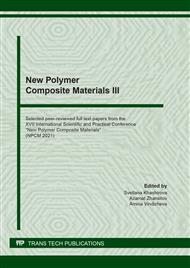[1]
V.G. Nikolskii, T.V. Dudareva, I.A. Krasotkina, et.al., Development and properties of new nanomodifiers for road pavement, Russian Journal of Physical Chemistry B. 8 (4) (2014) 577-583. https://doi.org/10.1134/S1990793114040071.
DOI: 10.1134/s1990793114040071
Google Scholar
[2]
ASTM D5644-18 Standard Test Method for Rubber Compounding Materials – Determination of Particle Size Distribution of Recycled Vulcanizate Particulate Rubber.
DOI: 10.1520/d5644-01
Google Scholar
[3]
ISO 13320 Particle size analysis – Laser diffraction methods. // GOST R 8.777-2011 State system for ensuring the uniformity of measurements. Disperse composition of aerosols and suspensions. Determination of particle sizes by laser diffraction.
Google Scholar
[4]
V. Lapkovskis, V. Mironovs, A. Kasperovich, V. Myadelets, D. Goljandin, Crumb Rubber as a Secondary Raw Material from Waste Rubber: A Short Review of End-Of-Life Mechanical Processing Methods, Recycling. 5(32) (2020) 1-20. https://doi.org/10.3390/recycling5040032.
DOI: 10.3390/recycling5040032
Google Scholar
[5]
Kravchenko I.B., Elastomeric materials containing a finely dispersed elastic filler obtained by the HTSG method: dissertation of a candidate of technical sciences: 05.17.06 / Kravchenko Ivan Borisovich., Moscow, (2008).
Google Scholar
[6]
A.A. Berlin, V. G. Nikolskiy, I. A. Krasotkina, T. V. Dudareva, et.al., Problems of effectiveness evaluation of modifiers introduced into asphalt concrete mixtures according to «Russian dry process», Vse Materialy. Entsiklopedicheskii Spravochnik. 2 (2021) 2-9. https://doi.org/10.31044/1994-6260-2021-0-2-2-9.
DOI: 10.1134/s1995421221030035
Google Scholar
[7]
GOST R 55419-2013 Composite material based on active rubber powder, modifying asphalt concrete mixtures. Technical requirements and test methods.
Google Scholar
[8]
F. Rouquerol, J. Rouquerol, K.S.W. Sing et.al., Adsorption by powders and porous solids: principles, methodology and applications, Amsterdam, Elsevier, (2014).
DOI: 10.1016/b978-0-08-097035-6.00003-6
Google Scholar
[9]
Sampling and sieving of crumb rubber (An Arizona Method). ADOT (2018) 8. Information on https://apps.azdot.gov/files/materials-manuals/materials-testing/ariz-714c.pdf.
Google Scholar
[10]
Yu.A. Naumova, I.V. Gordeeva, Analysis of mathematical models for description of the fractional composition of disperse elastic fillers, Russian Technological Journal. 7(5) (2019) 62-78 (in Russ.). https://doi.org/10.32362/2500-316X-2019-7-5-62-78.
DOI: 10.32362/2500-316x-2019-7-5-62-78
Google Scholar


